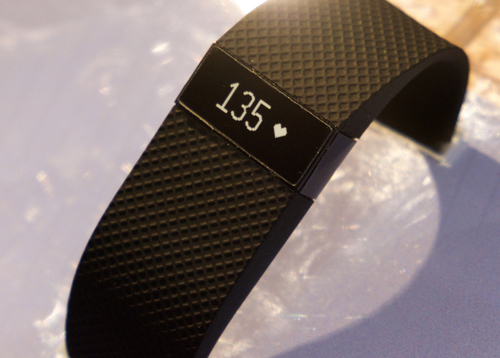ALAN TAYLOR looks at an some of the key benefits of the latest trend for wearable IT…

Wearable technology is not new. Hearing aids and calculator watches are examples that have been around since the 20th century. Entering the 21st century saw wearable technology such as the Hugshirt, Nicole Scherzinger’s Twitter dress and Google Glass (now discontinued).
But while those devices are innovative, none can claim to have saved lives like the latest wearable technology – fitness bands and smartwatches.

LIFE-SAVER? Devices like Apple Watch and Fitbit (pictured) have been credited with alerting people to potentially life-threatening medical issues. PICTURE: Kārlis Dambrāns/Flickr/CC BY 2.0/Image cropped
These devices have seen sales in their millions since their release. And although their primary purpose is for fitness tracking and notifications, it’s their life saving abilities that have sparked media attention. Let’s look at a few examples.
Apple Watch
The Apple Watch is now on version two, with greater processor speed, brighter display, waterproofing and inbuilt GPS. But it’s the first generation that made the news, with people claiming that the watch warned them of extreme heart rates.
In 2015, Chuck La Tournous experienced shortness of breath and a rapid heartbeat. Checking his Apple Watch, his heart rate was showing 118 beats per minute. His normal heart rate was in the low 70s. Sitting at his desk that morning, his rate never dropped below 100. As he was walking up a set of stairs at work, he had another episode. His Apple Watch displayed his heart rate as being more than 140 beats per minute. After reporting to his company nurse, he ended up in hospital with a diagnosis of ‘Factor V Leiden’, a genetic condition that develops clots in people over the age of 50. You can see his story here.
High school senior, Paul Houle, Jr, purchased an Apple Watch in early September, 2015. Days later he experienced back and chest pain after football practice. His watch showed his heart rate at 145 beats per minute, double his normal rate. An emergency room diagnosis showed he had rhabdomyolysis, a breakdown of muscle tissue that releases protein into the blood, which can cause organ damage. After a few days in hospital Paul was back at school. Paul’s story can be viewed here.
Dennis Anselmo, felt hot and cold at the same time. He checked his heart rate on his Apple Watch and saw his rate was over 200 beats per minute. Surgery revealed an artery in his heart was 70 per cent blocked. More on his story here.
Fitbit
The Fitbit now comes in a range of models from the Flex 2 to the top of the line Surge, a ‘super watch’ with GPS tracking.
Eighteen-year old Sarah-Jayne McIntosh claims her Fitbit saved her life. She was studying at university when her Fitbit alerted her that her heart rate had increased from 84 beats per minute to 210 beats per minute. Doctors used medication to slow her heart beat. The cause was due to a pathway to a chamber in her heart misfiring, effectively causing her to have two heartbeats. More of her story here.
A 42-year old man walked into an emergency room after a seizure. His heart rate was high, at 163 beats per minute and peaking at 190. Without tell-tale symptoms, doctors weren’t able to determine when his high heart rate started – which would change his treatment options. He could have required surgery if his heart rate was elevated for more than 48 hours. Staff noticed he was wearing a Fitbit and when they checked the data, saw his heart rate coincided with his seizure just two hours earlier. Doctors were able to shock his heart back to a regular rhythm and send him home. Without the Fitbit data, he may have had unnecessary surgery – read more here.
Grandfather Mick Schroeder was given a Fitbit by his daughter after he started having dizzy spells and fainting. The Fitbit data showed his heart rate was as low as 47 beats per minute to as high as 218 beats per minute. After rushing to hospital, Mick had a defibrillator placed above his heart. Monash Heart Cardiologist Dr Stuart Healy said Mick “could have passed away from this problem”. More details here.
It’s important to note that these devices are not recognised as medical equipment and their accuracy have been questioned – see here and here. But there’s no denying that, if the reports of the above situations are accurate, they’ve saved lives. Plus, the Apple Watch has now been updated with new software that allows the wearer to hold in the side button to automatically dial emergency services. At the same time, it will also notify up to three emergency contacts that the wearer is in trouble and sends location details which update whenever the wearer moves to a new location, such as hospital.
While some may see these devices as gimmicky, health manufacturers are seeing the potential to create products to increase their accuracy. One of these companies is AliveCor. Their soon-to-be-released Apple watch band is currently undergoing approval in the US. Their Kardia device is already US FDA approved, attaches to most Android and Apple devices and can give an accurate heart reading in 30 seconds.
With manufacturers cramming more features into devices, the benefits for the consumer can only get better. But of all the benefits, there’s only one that, if reports are true, could potentially could outweigh all the others. And it’s not a Twitter feed. It’s life.





